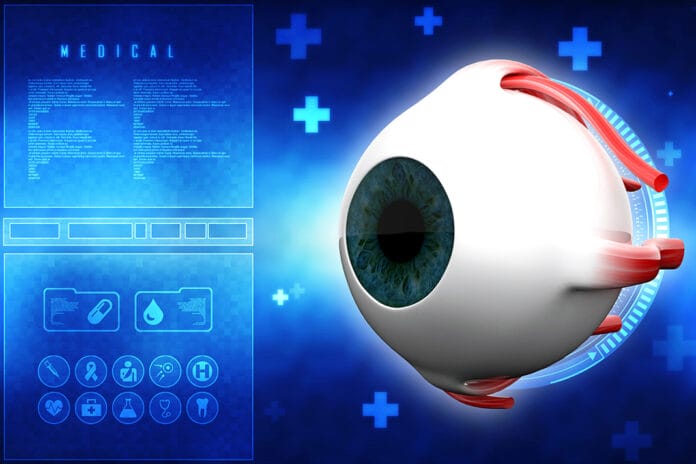For as long as I can remember, my dad put drops in his eyes. When I got older, I felt comfortable asking him what they were for, and his answer was glaucoma. I had my vision checked this summer and asked for a test to see if I was headed down the same path, and I realized I had no idea what it really was, who was at higher risk, or whether it was preventable. Further, does glaucoma have an oral-systemic link or affect dental treatment?
Glaucoma is a group of optic nerve diseases that can lead to blindness. An eye has more than a million nerve fibers, and the optic nerve connects the retina to the brain. Pressure on those nerves can increase the risk of optic nerve damage. It is more common in older adults, and over three million Americans are afflicted, costing the United States $2.86 billion annually.1
High eye pressure increases your risk of glaucoma, but not everyone with high eye pressure will develop glaucoma. Most people’s eye pressure above 21 mmHg is typically associated with glaucoma, but eye damage can occur with lower pressure.2
Fluid normally flows out of a space between the cornea and the iris called the anterior chamber. When pressure elevates, fluid can’t drain normally. The opening has a spongy tissue called the trabecular meshwork. Sometimes the meshwork blocks the fluid from draining back into the bloodstream, elevating pressure inside the eye.2
Prevention can be confusing. There is no current way to prevent primary glaucoma. However, there is prevention of blindness from glaucoma. Some types of secondary glaucoma are caused by an underlying condition – such as eye infections, inflammation, medications, previous eye injuries, or eye surgery – that can be prevented.3
Primary Open-angle and Closed-angle Glaucoma
In open-angle glaucoma, the fluid passes too slowly; in closed-angle glaucoma, the opening becomes entirely blocked by the outer edge of the iris. Initially, in open-angle, there can be no symptoms. But peripheral vision is lost at some point, and without treatment, a person can become totally blind. 4,5
Some risk factors for open-angle glaucoma are diabetes, high blood pressure, eye injury, or the use of corticosteroids. Nine in 10 people with glaucoma have open-angle, which can be hereditary. There is a higher risk with an immediate family member, and researchers have identified at least 16 genes that cause this glaucoma to date.4,5
Closed-angle glaucoma or narrow-angle glaucoma is much less common. The meshwork is obstructed or damaged, and there are two forms: acute or chronic. Acute is when the normal flow of aqueous humor (the clear fluid filling the space in the front of the eyeball between the lens and the cornea) suddenly becomes blocked. This is a medical emergency as it can cause blindness within days.5
Chronic closed-angle glaucoma progresses slowly and can produce damage without symptoms such as open-angle glaucoma.5
In Dentistry, Why Does This Matter?
I have been administering local anesthesia since 1989, when I became licensed in Oklahoma. I recently was doing research on something else related to epinephrine, and I found that for closed-angle glaucoma, epinephrine is a relative contraindication.6 I reached out to an optometrist friend, Dr. David Free, in Tulsa, and yes, that is true.
I immediately had the question: Is glaucoma even on a health history? If so, do we ask what kind a patient has? That led me down my typical rabbit hole of researching glaucoma, and I found a feast of why we should care about this eye disease.
In 2021, a retrospective case-controlled study looked at periodontal disease as related to glaucoma. They found a statistically significant increased prevalence of periodontal disease among older patients with glaucoma aged 70 to 79 compared to controls. The association was not found to be similarly significant within other age ranges.7
An infection in the ear, nose, or throat can cause pressure in the optic nerve, and it is important that any infection be treated quickly. Oral infections, especially those connected with dental diseases, may trigger a series of events where the bacteria from an infected tooth or inflamed gingiva spread to the optic nerve.8
Certain bacterial species in the oral cavity can and do serve as a catalyst for pro-inflammatory responses in our immune system. On a cellular level, the presence of inflammation may lead to oxidative stress on tissues and cause damage. Open-angle glaucoma is usually triggered by oxidative stress damage, mitochondrial dysfunction, and abnormal accumulation of metabolites in trabecular meshwork cells, causing loss of cellular function.9,10
A pilot case-controlled study, albeit a small sample size with limited resources, had a hypothesis that chronic inflammation linked to the oral microbiome was a potentially modifiable risk factor associated with chronic open-angle glaucoma. Their results suggested an inverse relationship between having more teeth and the odds of having primary open-angle glaucoma. Even more interesting, it was suggested that past dental infections may be more important than recent infections in glaucoma development.11
Findings in another study suggest that oral microbiome (high bacterial load) contributes to glaucoma pathophysiology, and patients with glaucoma had higher bacterial loads in the oral cavity compared with people without glaucoma.12
I did a very unscientific poll on social media asking how many offices had glaucoma on the health history. There were plenty that did, which is terrific, but there were enough that didn’t. If there is a relationship between periodontal disease and glaucoma, we should know more, especially if periodontal disease precedes the glaucoma diagnosis.
In yet another unscientific poll, hygienists who understood glaucoma erred on the side of caution and did not use epinephrine. It does beg the question, if we saw this on a health history, is there a follow-up question as to what kind? Will a patient list their eye drops as a medication? Should the patient disclose their eye drops? You may see names of eye drops like Xalatan, Tracata Z, Zioptan, Lumigan, Rhopressa, Vyzulta, Betoptic, or what my dad used, Timoptic.
Periodontal disease and oxidative stress accompany each other, and oxidative stress has a significant role in glaucoma.13,14 Make no mistake, you are fighting the good fight and helping patients in such significant ways. Carry on, oral health specialists.
Before you leave, check out the Today’s RDH self-study CE courses. All courses are peer-reviewed and non-sponsored to focus solely on high-quality education. Click here now.
Listen to the Today’s RDH Dental Hygiene Podcast Below:
References
- Current Glaucoma Programs. (2022, November 7). Centers for Disease Control and Prevention. https://www.cdc.gov/visionhealth/research/projects/ongoing/glaucoma.htm
- Glaucoma and Eye Pressure. (2022, March 25). NIH: National Eye Institute. https://www.nei.nih.gov/learn-about-eye-health/eye-conditions-and-diseases/glaucoma/glaucoma-and-eye-pressure
- What is Secondary Glaucoma? (n.d.) Glaucoma Research Foundation. https://glaucoma.org/what-is-secondary-glaucoma/
- Wiggs, J.L., Pasquale, L.R. Genetics of Glaucoma. Hum Mol Genet. 2017; 26(R1): R21-R27. https://www.ncbi.nlm.nih.gov/pmc/articles/PMC6074793/
- Types of Glaucoma. (2021, September 10). NIH: National Eye Institute. https://www.nei.nih.gov/learn-about-eye-health/eye-conditions-and-diseases/glaucoma/types-glaucoma
- Dalal, R., Grujic, D. (2023, May 1). Epinephrine. StatPearls. https://www.ncbi.nlm.nih.gov/books/NBK482160/
- Coggins, K., Husain, A., Parsegian, K., Whitson, J.T. Association between Poor Oral Health and Risk of Glaucoma. Invest Ophthalmol Vis Sci. 2021; 62(8): 1605. https://iovs.arvojournals.org/article.aspx?articleid=2775177
- Eye Diseases Associated with Oral Pathogens. (2022, June 27). Scholarly Community Encyclopedia. https://encyclopedia.pub/entry/24314
- Itakura, T., Peters, D.M., Fini, M.E. Glaucomatous MYOC Mutations Activate the IL-1/NF-κB Inflammatory Stress Response and the Glaucoma Marker SELE in Trabecular Meshwork Cells. Mol Vis. 2015; 21: 1071-1084. https://pubmed.ncbi.nlm.nih.gov/26396484/
- Tabak, S., Schreiber-Avissar, S., Beit-Yannai, E. Crosstalk between MicroRNA and Oxidative Stress in Primary Open-Angle Glaucoma. Int J Mol Sci. 2021; 22(5): 2421. https://www.ncbi.nlm.nih.gov/pmc/articles/PMC7957693/
- Polla, D., Astafurov, K., Hawy, E., et al. A Pilot Study to Evaluate the Oral Microbiome and Dental Health in Primary Open Angle Glaucoma. J Glaucoma. 2017; 26(4): 320-327. https://journals.lww.com/glaucomajournal/abstract/2017/04000/a_pilot_study_to_evaluate_the_oral_microbiome_and.5.aspx
- Astafurov, K., Elhawy, E., Ren, L., et al. Oral Microbiome Link to Neurodegeneration in Glaucoma. PLoS One. 2014; 9(9): e104416. https://pubmed.ncbi.nlm.nih.gov/25180891/
- Sczepanik, F.S.C., Grossi, M.L., Casati, M., et al. Periodontitis is an Inflammatory Disease of Oxidative Stress: We Should Treat It That Way. Periodontol 2000. 2020; 84(1):45-68. doi:10.1111/prd.12342 https://pubmed.ncbi.nlm.nih.gov/32844417/
- Izzotti, A., Bagnis, A., Saccà, S.C. The Role of Oxidative Stress in Glaucoma. Mutat Res. 2006; 612(2): 105-114. https://pubmed.ncbi.nlm.nih.gov/16413223/












